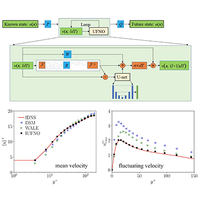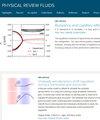Prediction of turbulent channel flow using Fourier neural operator-based machine-learning strategy
IF 2.5
3区 物理与天体物理
Q2 PHYSICS, FLUIDS & PLASMAS
引用次数: 0
Abstract
Fast and accurate predictions of turbulent flows are of great importance in the science and engineering field. In this paper, we investigate the implicit U-Net enhanced Fourier neural operator (IUFNO) in the stable prediction of long-time dynamics of three-dimensional (3D) turbulent channel flows. The trained IUFNO models are tested in the large-eddy simulations (LES) at coarse grids for three friction Reynolds numbers: , 395, and 590. The adopted near-wall mesh grids are tangibly coarser than the general requirements for wall-resolved LES. Compared to the original Fourier neural operator (FNO), the implicit FNO (IFNO), and U-Net enhanced FNO (UFNO), the IUFNO model has a much better long-term predictive ability. The numerical experiments show that the IUFNO framework outperforms the traditional dynamic Smagorinsky model and the wall-adapted local eddy-viscosity model in the predictions of a variety of flow statistics and structures, including the mean and fluctuating velocities, the probability density functions (PDFs) and joint PDF of velocity fluctuations, the Reynolds stress profile, the kinetic energy spectrum, and the Q-criterion (vortex structures). Meanwhile, the trained IUFNO models are computationally much faster than the traditional LES models. Thus, the IUFNO model is a promising approach for the fast prediction of wall-bounded turbulent flow.

利用基于傅立叶神经算子的机器学习策略预测湍流通道流动
快速准确地预测湍流在科学和工程领域具有重要意义。在本文中,我们研究了隐式 U-Net 增强傅立叶神经算子(IUFNO)在稳定预测三维(3D)湍流通道流的长时间动力学方面的应用。在三种摩擦雷诺数的粗网格大涡流模拟(LES)中测试了训练有素的 IUFNO 模型:Reτ≈180、395 和 590。所采用的近壁网格比一般的壁面分辨 LES 要求更粗。与原始傅立叶神经算子(FNO)、隐式 FNO(IFNO)和 U-Net 增强 FNO(UFNO)相比,IUFNO 模型的长期预测能力更强。数值实验表明,IUFNO 框架在预测各种流动统计量和结构(包括平均速度和波动速度、速度波动的概率密度函数(PDF)和联合 PDF、雷诺应力谱、动能谱和 Q 准则(涡旋结构))方面优于传统的动态 Smagorinsky 模型和壁面适应性局部涡粘度模型。同时,训练有素的 IUFNO 模型的计算速度比传统的 LES 模型快得多。因此,IUFNO 模型是快速预测壁面湍流的一种有前途的方法。
本文章由计算机程序翻译,如有差异,请以英文原文为准。
求助全文
约1分钟内获得全文
求助全文
来源期刊

Physical Review Fluids
Chemical Engineering-Fluid Flow and Transfer Processes
CiteScore
5.10
自引率
11.10%
发文量
488
期刊介绍:
Physical Review Fluids is APS’s newest online-only journal dedicated to publishing innovative research that will significantly advance the fundamental understanding of fluid dynamics. Physical Review Fluids expands the scope of the APS journals to include additional areas of fluid dynamics research, complements the existing Physical Review collection, and maintains the same quality and reputation that authors and subscribers expect from APS. The journal is published with the endorsement of the APS Division of Fluid Dynamics.
 求助内容:
求助内容: 应助结果提醒方式:
应助结果提醒方式:


